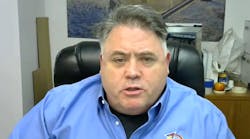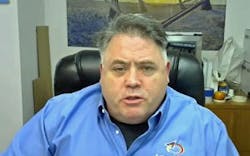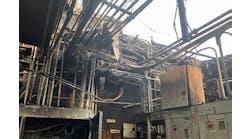Navy overhauls boiler controls with PlantPAx
“The original control room had one computer per boiler, and operators moved from computer to computer to control the boilers. Now, the room has 15 screens that are separate clients, so any monitor can be used for any system in the plant.” Systems Interface’s Craig Beesley explained the increased operational flexibility offered by the new PlantPAx system at U.S. Naval Base Kitsap.
When U.S. Naval Base Kitsap planned to migrate its steam plant from an obsolete Westinghouse WDPF distributed control system (DCS) to PlantPAx, Rockwell Automation and integrator Systems Interface partnered to design and deliver a modern system with integrated burner management and combustion control systems. Extensive up-front migration and acceptance-test planning for all hardware, software and control strategies allowed project execution during ongoing operations, with no loss of steam availability.
Naval Base Kitsap, near Bremerton on Puget Sound, has three 140,000-lb/hr dual-fuel boilers with two burners each to provide redundancy and a seasonably variable steam supply. “As designed and commissioned in August, 1989, the WDPF DCS with Coen burner control was very specific to boiler control,” said Craig Beesley, engineering manager, Systems Interface Inc., in his Process Solutions User Group co-presentation with Matt Baker, manager, strategy and marketing, Systems Interface, this week at the Automation Fair at Home.
Other controller-based systems have since became user-configurable, so the Navy had trouble finding support for both the control and burner systems. “Feedwater, diesel fuel and condensate I/O were intertwined with boiler I/O, making it hard to troubleshoot and repair without an unplanned shutdown,” Beesley said. “Shutdowns interrupted steam to all base operations, including space heating.”
The Navy had since standardized on Allen-Bradley equipment for consistency and serviceability, so it sought a Rockwell Automation solution. The team included Absher Construction, Puyallup, Washington as the general contractor; the Rockwell Automation Industrial Combustion and Steam Generation (ICSG) team for burner and combustion control expertise; and Systems Interface as system integrator. Systems Interface has been a Rockwell Automation partner for many years for control systems, and has also become a partner for drives and process control.
Along with replacing the WDPF, the new system was to provide a better controlled fuel burn, particularly on diesel fuel, to increase efficiency and reduce odor complaints. This was done in part by converting the fixed-speed burner fans to variable-speed using Allen-Bradley PowerFlex 750-Series drives. The PlantPAx system was also to separate all auxiliary systems to ease troubleshooting, with the separated systems integrated in a single control room.
“The first step was to document every aspect of the existing system. Did it exist? Was it being used? Where is it located?” Beesley said.
To maintain steam, the Navy required that one boiler always be available, and a second on standby. “So, the plan was to cut one boiler at a time over to the new system, surgically removing auxiliary systems while not interrupting steam flow,” Beesley said. The procedure was extensively discussed, planned, coordinated and documented, and was done one loop at a time, unwiring from the old system, wiring to the new system and recommissioning. To maintain control, signals had to be duplicated and sent to the plant master system for the feedwater, motor cooling, reverse osmosis and other systems.
The PlantPAx system has redundant processors for immediate failover. Human-machine interfaces (HMIs) with FactoryTalk View SE clients in each plant allow local boiler control. Burner management and combustion control are on separate systems with a redundant ring topology and fiber to the PlantPAx server in the central control room.
Federal regulations require dual fuels, but the old DCS could not run both fuels on the same boiler by running diesel on one burner and natural gas on the other. This is easily done with the new system.
“The original control room had one computer per boiler, and operators moved from computer to computer to control the boilers,” Beesley said. “Now, the room has 15 screens that are separate clients, so any monitor can be used for any system in the plant.”
The Rockwell Automation ICSG team and Systems Interface worked closely on the boiler HMIs and screens in the control room, and dialed in the design and function of the faceplates of the boiler management and combustion control systems. System training was performed on each part of the system as it came online. “Operations had to use both the old and new systems together so by the time we switched over the third boiler, operators were familiar with the new system,” Beesley said. “`They also received a week of comprehensive training at the end of the project.”
The first boiler to be refitted was No. 3, as it had no economizer, and was done in the fall of 2017. No. 2 boiler was delayed until the spring of 2019, for unrelated reasons, and No. 1 followed in the fall of 2019. Each boiler took five to six weeks to complete.
“The Rockwell Automation ICSG partnership is a best-in-class strategy,” said Baker. “We’re a systems integrator—Rockwell Automation has been doing burner management for a long time, we have not. They know the standards and regulations—FM, NFPA, etc.”
According to Baker and the Navy, keys to success included working closely with Rockwell Automation, the consulting engineers, and the general contractor, with a close collaborative relationship between Rockwell Automation and Systems Interface. Success also was assured by a common software, look and feel; a lot of time on the base for commissioning; and the fact that it was an iterative project. “Lessons learned on the first and second boilers were used on the second and third,” Baker said. It helped that training was performed along the way.
The Navy specified Rockwell Automation for familiarity and to ease internal support, and now, “The Navy is able to support the system, which they couldn’t do with the Westinghouse DCS,” Baker said. “The old system was too tightly coupled – comingled. Now it’s integrated but separated enough to do maintenance and troubleshooting without bringing the boilers down.”
The editors of Control, Control Design and Smart Industry are providing coverage of Automation Fair At Home, bringing you breaking news, innovations and insights from the virtual event. Once Automation Fair At Home is over, the editors will put together an event report featuring the top news. Pre-order your copy today.






